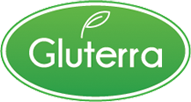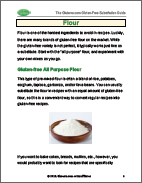Submitted by Andrew on March 11, 2013
![]() You know what a muffin top is don't you? Just in case you haven't figured it out, it's the roll of stomach fat that rolls over your belt or waistband, looking much like the top of a muffin. If you have one and have become attached to it, more power to you. If don't like it and want to get rid of it, then it's time to pay attention.
You know what a muffin top is don't you? Just in case you haven't figured it out, it's the roll of stomach fat that rolls over your belt or waistband, looking much like the top of a muffin. If you have one and have become attached to it, more power to you. If don't like it and want to get rid of it, then it's time to pay attention.
Following is the first of 3 simple (I didn't say easy) steps to lose your muffin top.
Step 1 - A Gluten-free diet
When I was diagnosed initially with severe gluten intolerance and gastritis because of it, I panicked. I first had to learn what it was, but then I started reading all the labels in my pantry and was quite surprised when there were very few things that I could eat. I had to throw out or give away most everything I had in there. I found out that getting rid of gluten from my diet is like getting rid of corn — some form of it seems to be in every processed food in the pantry! Little did I know that that's a blessing in disguise.
In addition to gluten intolerance, I was also allergic to casein (the proteins in dairy) and was already mostly a practicing vegetarian. I say mostly because I would eat Salmon and other seafood on occasion which technically made me a "Pescetarian" — a vegetarian that also eats seafood.
In the six weeks after being diagnosed with gluten intolerance, I lost almost 20 pounds without trying at all. I weighed about 185 when I started and went down to about 165. Weight is not the best barometer, but this gives you an idea. Some of my colleagues started getting concerned as I began to get skinnier. I wasn't sick per se, but I was trying to avoid all the foods I couldn't eat, and they seemed to be everywhere. And, my symptoms were bad enough where I was scared to eat anything that the lab tests revealed that I shouldn't eat -- NO gluten and NO Dairy.
Being a little panicked and losing weight that way is not what I am talking about, but a gluten-free diet, without all the bad-for-you substitutions, may be the silver bullet that you need to break free of the diet roller coaster you've been on for years.
As you may already know, gluten is typically associated with many foods that are of little nutritional value. We're talking pasta, breads, crackers, bagels, donuts, beer, cereals, potentially french fries, and more. All starchy carbs. We all love these items on one level or another (my Kryptonite is french fries - yummy!), but on a gluten-free diet you should be avoiding all of these items.
The problem with starchy simple carbs is that it increases your insulin response. Your insulin response is when your blood sugar goes up as a result of you eating that doughnut (insert your favorite carb here), and then your pancreas releases more insulin into your system to bring your blood sugar back down to normal levels. That one insulin response action has been scientifically proven to drive calories into fat cells where your body can use it for long-term storage. This is a survival mechanism built into the make-up of our human bodies, but in this day and age with much easier access to food than even 100 years ago (a blip on the human existence timeline), we don't want to save those calories for the long-term just in case we need them. We have to undo evolution, which is not that easy as most of you have figured out.
Plus, according to a study at Tufts University at the USDA Human Nutrition Research Center, eating starchy carbs triggers cravings for these items later in the day. The take away? Eat doughnuts for breakfast and you've set yourself up for a problem later in the day when you have intense cravings to polish off the rest of the left-over coffee cake that was left in your company's break room from that morning. Not. Good. At. All!
Another advantage of going gluten-free is that it shifts the emphasis from processed foods to good nutritional veggies, fruits, nuts and even lean meats if you are not a vegetarian. And I'll state again, "unless you learn about all of the bad-for-you substitutions" because if you learn all of the bad substitutions, you are simply substituting one nutrition-less carb for a gluten-free nutrition-less carb.
So you may be saying, "give me a real life example." Okay, here goes. Say you want to eat Italian and you've been dreaming about Bruschetta as an appetizer, perfectly cooked al dente Italian Pasta and meatballs as your entree, and Tiramisu for dessert. Unless you cook it yourself using gluten free substitutes, that sumptuous Italian meal will have gluten in it — ALL three courses! When you substitute ingredient for ingredient, instead of replacing with healthier alternatives, you are indeed getting rid of the gluten, a good thing, but you are also getting the same nutrition-less, carby (is that a word? it is now) foods as you were before you substituted. Not good because it will spike your blood-sugar, create an insulin response and drive calories into fat cells for long-term storage. Sound familiar?
So how would you make that Italian meal a healthy alternative instead of just substituting with gluten-free ingredients? Off the top of my head as I write this, I would say, a simple mixed green salad (not iceberg lettuce please since it is mainly water), with some chopped organic red bell-pepper, sliced burpless organic English cucumbers with organic balsamic vinegar and organic extra-virgin olive oil (or even cold-pressed organic flax seed oil) for the dressing. Add some crunchy roasted or candied pecans and cran-raisins to give it a little extra something. Then I would say if you are a meat-eater, some organic grilled Chicken breast with marinara on top and steamed organic broccoli for the entree, skip the pasta, gluten-free or otherwise. For you vegetarians out there, some gluten-free egg-plant parmesan, and of course skip the pasta. Then for dessert, you could have some Gelato or some dairy free Lemon Sorbet and add a small GF chocolate cookie for some contrast in texture and to add a little hint of chocolate and sweetness. Ok, so we had one little substitute — a GF chocolate chip cookie for those of you that just have to have dessert. Most of the time I try and cut the dessert out completely, but I might sneak a tiny square (size of a quarter) of dark chocolate just to finish off the meal. You still get that chocolate dessert-like taste at a fraction of the hassle and calories.
 The key is to make this gluten-free quest you are on, not one just to find ingredient substitutes, but to look at it as a wake-up call for a different way of life and to concentrate on finding meal replacements. It means not to go out of your way to find every little substitution, because they all exist. It means you should search for healthy alternatives without all the direct gluten to gluten-free substitutions. It means that you should embrace, as much as possible, your new way of eating for a healthier you. A great rule of thumb: if it doesn't spoil soon after you buy it, then it may not hold the best nutritional value and it is best to try and avoid.
The key is to make this gluten-free quest you are on, not one just to find ingredient substitutes, but to look at it as a wake-up call for a different way of life and to concentrate on finding meal replacements. It means not to go out of your way to find every little substitution, because they all exist. It means you should search for healthy alternatives without all the direct gluten to gluten-free substitutions. It means that you should embrace, as much as possible, your new way of eating for a healthier you. A great rule of thumb: if it doesn't spoil soon after you buy it, then it may not hold the best nutritional value and it is best to try and avoid.
Having said that, it makes life a little nicer to be able to occasionally eat the things you really like that normally contain gluten. If you do it sparingly, then finding that perfect recipe that includes gluten-free ingredient substitutions is a welcomed treat and lifts the spirit. Just make sure to do this in moderation if you want to lose that muffin top. Check out our tons of gluten-free recipes on this site for some inspiration!
By going gluten-free, I've made (okay, okay, my wife has made) much simpler meals and learned to buy the best organic ingredients I (she) can find. I've learned to embrace the simpleness that gluten-free cooking has brought about and let the quality ingredients be the star of the show instead of the sauces and complex creations.
So, are you committed to a healthier set of meal replacements on your gluten-free diet?
Ready for the next step? Step 2 »
- Login to post comments


 Click here to get a FREE GF Substitution Guide!
Click here to get a FREE GF Substitution Guide! 
 Sign-up to become a part of our gluten-free community. As a gift for being a free member, you can download our Gluten-Free Substitution Guide -- over 40 pages of great gluten-free substitutes. As a member, we will also send you our latest updates, recipes, and special offers. We'll try not to bug you and we won't share your info.
Sign-up to become a part of our gluten-free community. As a gift for being a free member, you can download our Gluten-Free Substitution Guide -- over 40 pages of great gluten-free substitutes. As a member, we will also send you our latest updates, recipes, and special offers. We'll try not to bug you and we won't share your info.